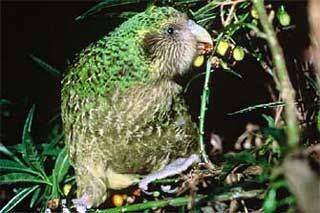Birds: Kakapo Parrot

Description:
The Kakapo (Maori for night parrot), Strigops habroptilus (from the Greek strix, genitive strigos: owl and ops:face; and habros: soft, and ptilon:feather.), is a species of nocturnal parrot endemic to New Zealand. It is notable for being the world's only flightless parrot, the heaviest parrot, and the only parrot to have a lek breeding system. It is also the only flightless lek bird and is possibly the world's longest-lived bird. It is the only species in the genus Strigops and subfamily Strigopinae. This species is often confused with the two other New Zealand parrots, the Kaka and the Kea.
Kakapo are critically endangered, with only 87 living individuals known, all of whom are named. Prehistorically, the ancestral Kakapo migrated to the islands of New Zealand and, in the absence of mammalian predators, it lost the ability to fly. With European and Polynesian colonization and the introduction of predators such as cats, rats, and stoats, almost all the kakapo were wiped out. In 1995, there were only 50 known surviving individuals.
Read the whole, extensive Wikipedia article here.
And check out the Kakapo conservation compaign.



2 Comments:
Wow - thats one fine looking bird you have there!
By Anonymous, at 16:20
Anonymous, at 16:20
hiiiiiiiiiiiiiiiiiiiiiiiiiiiii
By Anonymous, at 04:11
Anonymous, at 04:11
Post a Comment
<< Home